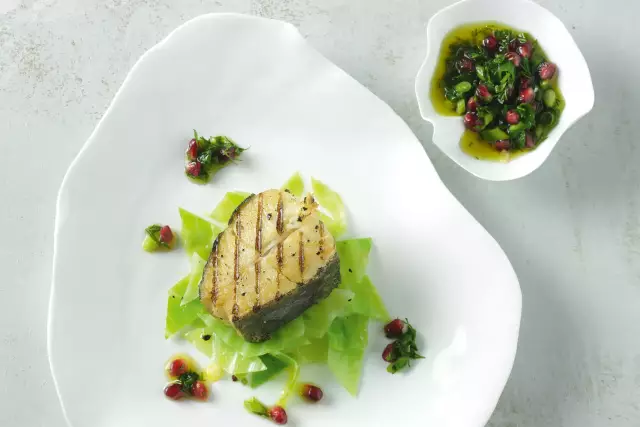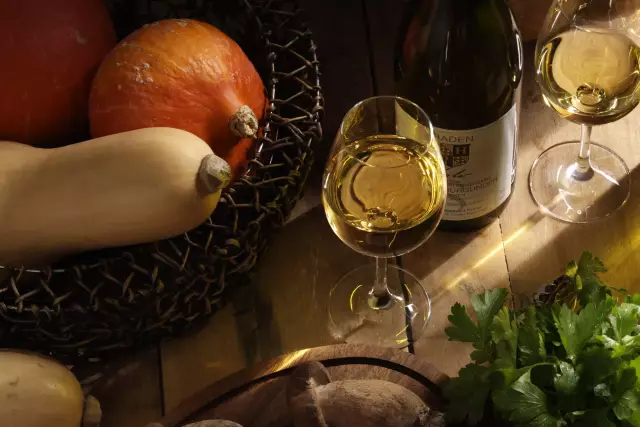Barbecue & Wine
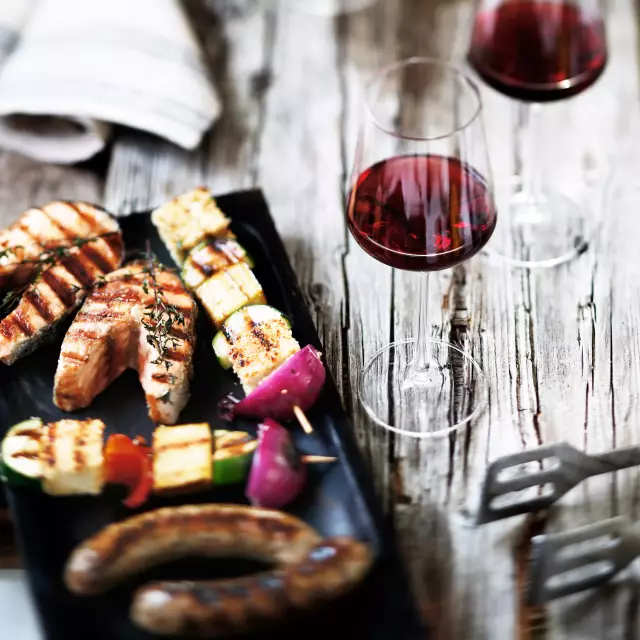
During the last couple of years, the classic barbecue has been turned into sophisticated outdoor cooking. The demands on the quality of the meat, fish and vegetables used have increased just as much as the desire to have the perfect wine to accompany the food.
Facts
-
April
is the most popular month to start the barbecue season
-
39,19 %
of consumers have a barbecue every two weeks
-
80 %
are equipped with a gas grill
When choosing a wine for your barbecue, you have to bear in mind that the taste of the grilled foodstuffs is often more intense than if they were fried in a pan, owing to the roast aromas and smoke flavors. Thus even a red wine might sometimes be a suitable partner for a grilled fish or white meat. Velvety Pinot Noir or fruity Saint Laurent spring to mind. They are low in tannins and boast a subtle fruitiness – thus they do not drown out the white meat or fish.
In case the grilled meat has stronger roast aromas, it’s better to serve a Lemberger or Dornfelder - preferabley aged in a barrique barrel - along with it, since these wines are richer in tannins by nature.
What is being barbecued?
Schnitzel, pork steaks and similar meats are often marinated in oil, garlic, herbs and spices. Ideal wine companions are hearty Riesling or Pinot Blanc, as well as dry rosé wines, e.g. based on Pinot Noir.
Beef: If you want to treat your guests to something really special, go for Dry Aged Beef. The dry, well-hung beef matures at constant humidity levels of 60% and – depending on the piece – between 7 and 28 days. Connoisseurs salt the steak about 15 minutes prior to putting it on the grill to get more roast aromas. Then they grill the meat on thoroughly glowing coal for one minute per side, before cooking it on indirect heat until it reaches the desired core temperature. Pepper is only added at the end. A premium piece of meat does not require anything more than a red wine that is its equal in quality, such as a strong Lemberger. This Lemberger should have aged in barrique – for quite some time, ideally – so that its tannins have mellowed.
Fillet of beef or entrecote on the grill are done faster than rib eye. Consequently, they are not as rich in roast aromas. A velvety Pinot Noir is an excellent choice to accompany them.
Along with a lamb cutlet with a Mediterranean seasoning, grilled to crispy perfection, we recommend a hearty Lemberger or Dornfelder, aged in a barrique barrel, if you like.
Poultry – chicken breast, turkey escalope or breast of duck: The tender meat gets a more intense taste on the grill, which goes very well with a dry rosé. In general, rosé wines are great partners for a carefree barbecue enjoyment.
Fish such as trout, char and gilthead are often softer and juicier when grilled wrapped in tin foil rather than directly on the grate. Pinot Blanc, Chardonnay and Silvaner are perfect companions. A light Riesling from the Moselle with subtle fruitiness is welcome as well.
If the fish is prepared directly on the grate or in a grill tray, maybe even marinated or strongly seasoned, it required a partner such as a stronger Riesling or Chardonnay. A lightly chilled dry red wine can also be an adequate companion for heartily seasoned fish.
Whole fish with herbs can take a juicy Silvaner, which also boats herbal aromas – or even a red wine that is not too full-bodied.
Shellfish such as scampi and prawns are roasted in a grill tray inside their shell, so they don’t lose too much of their juice. All seafood should never be cooked for too long or over too much heat. This kind of seafood likes a fresh Pinot Blanc.
Silvaner, Müller-Thurgau or Pinot Gris are delightful companions for vegetarian and vegan treats. With their subtle aromas, they bring out the best in the vegetables. And – a universal truth – a dry rosé is always a great choice. Vegetables excellently suited for a barbecue are eggplant or oyster mushrooms, served on a plate with hummus or tzatziki. Vegetable skewers – for instance with cherry tomatoes, chunks of zucchini, stripes of bell pepper and tofu – are delicious as well.
And for those who prefer an Asian-style barbecue, we recommend a semi-dry Riesling. You can even try a sweet Riesling if things get really hot, because the wine’s sweetness will soften the spiciness of the food.
Chilling wine
In the summer, wines should generally be served 2-3 °C colder, because they very quickly warm up in the glass. You might even opt to lightly chill red wines in summer, if they are not too complex and rich in tannins.
Chill with ice
If you are in a hurry, just place the wine bottle inside a champagne cooler or a large bowl filled with ice that has been sprinkled with a handful of salt. This will make the ice thaw faster and increase cooling by evaporation. If you lightly move the bottle inside the ice, you heighten the cooling effect.
Cooling cuffs
You should always keep some cooling cuffs for wine bottles ready in the freezer. They are pulled over the wine bottle and chill the wine down to the prefect drinking temperature within about 10-15 minutes. The cooling cuffs come in different sizes – there are varieties for slim wine bottles as well as more bulbous Sekt bottles.
Bottle coolers
Bottles that have already been chilled keep their temperature for a longer time in wine coolers made of clay, perspex or stainless steel. In order to add to the effect, you can put some ice into the cooler.
When do fish and red wine go together?
This combination is highly recommended when grilling fish, because roasted and smoky aromas intensify the flavor of the grilled food. Velvety Pinot Noirs or a fruity Saint Laurent are quite suitable companions here.
Varietals

More recipe ideas
the classic with a difference Franconian cider soup
the classic with a difference
- 500 ml Weißwein (Spätlese)
- 500 ml Geflügelbrühe
- 350 ml Sahne
- 30 Gramm Zwiebeln
- 30 Gramm Weißes vom Lauch
- 30 Gramm Sellerie
- 30 Gramm Karotten
- 30 Gramm Butter
- 180 Gramm Mehl
- 2 Lorbeerblätter
- 1 EL Butterschmalz
- 4 Scheiben Weißbrot
- Nach Belieben Zucker, Muskat, Zimt, Salz
Sauté the vegetables in butter until lightly browned, dust with flour and then add the vegetable stock, wine and 250 ml cream. Add the spices and simmer for approx. 15 minutes.
Remove the crusts from the slices of white bread and cut into 1 cm cubes. Fry in hot clarified butter until golden brown and season with cinnamon, whip the remaining cream until stiff.
<p
<p> Strain the soup and flavour with nutmeg and salt.
Pour into deep plates, garnish with whipped cream and the cinnamon crusts.
- Müller-Thurgau (trocken)
- Silvaner (trocken)
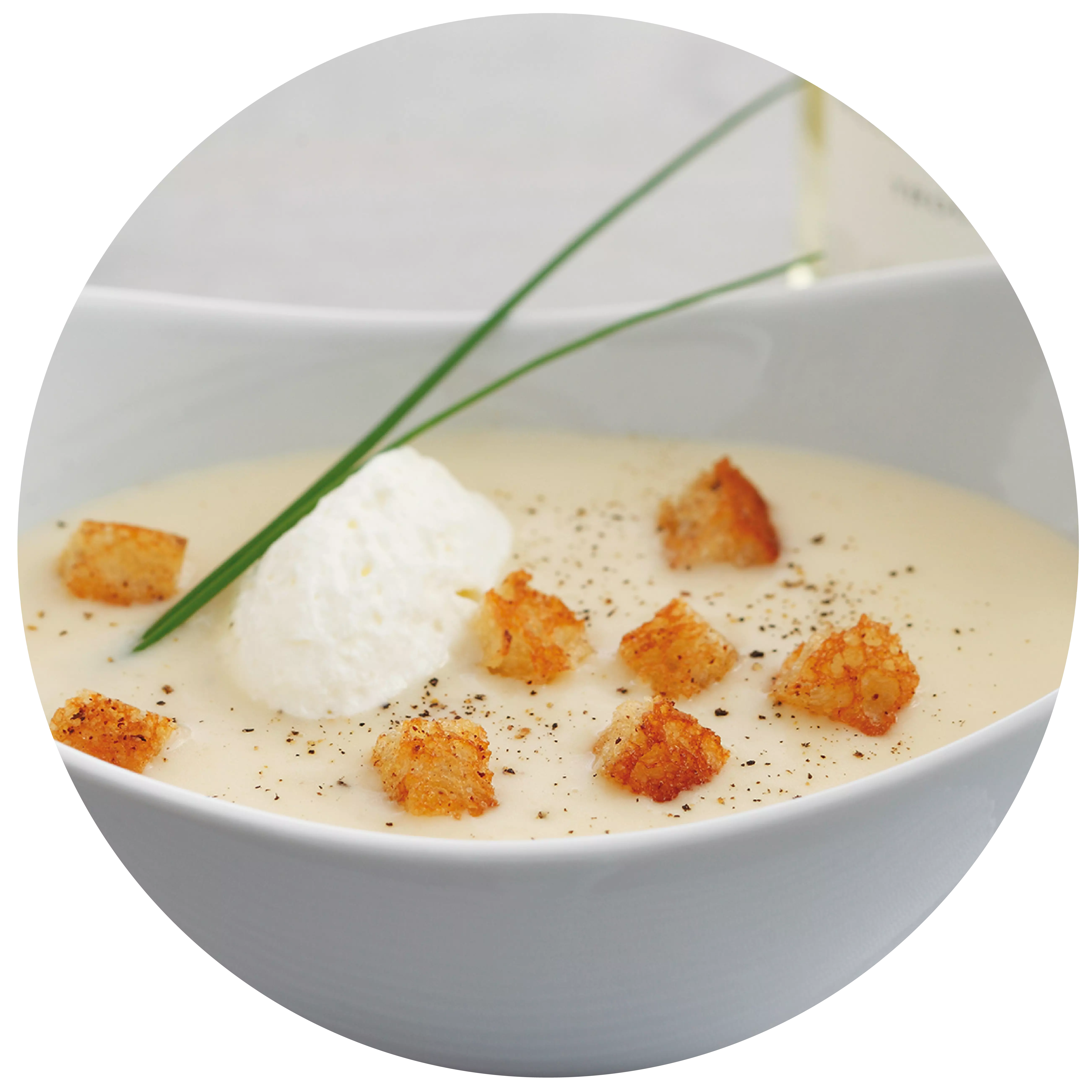
with semi-dry wines Flädlesuppe
with semi-dry wines
- 1 Bund Schnittlauch
- 1 Liter Fleischbrühe
- 150 Gramm Weizenmehl
- 300 ml Milch
- nach Belieben Speckschwarte zum ausreiben der Pflanne
- Etwas Salz
Make a smooth, not too thick batter from the flour, milk, eggs and a pinch of salt. Heat a heavy frying pan on a high heat, rub with bacon fat, pour in a small dollop of batter, allow to spread and fry thin pancakes (flädle).
<p
<p>Leave the pancakes to cool, halve and cut into thin strips.
Place in clear, very hot meat stock and serve immediately.
<p- Trollinger (halbtrocken & feinherb)
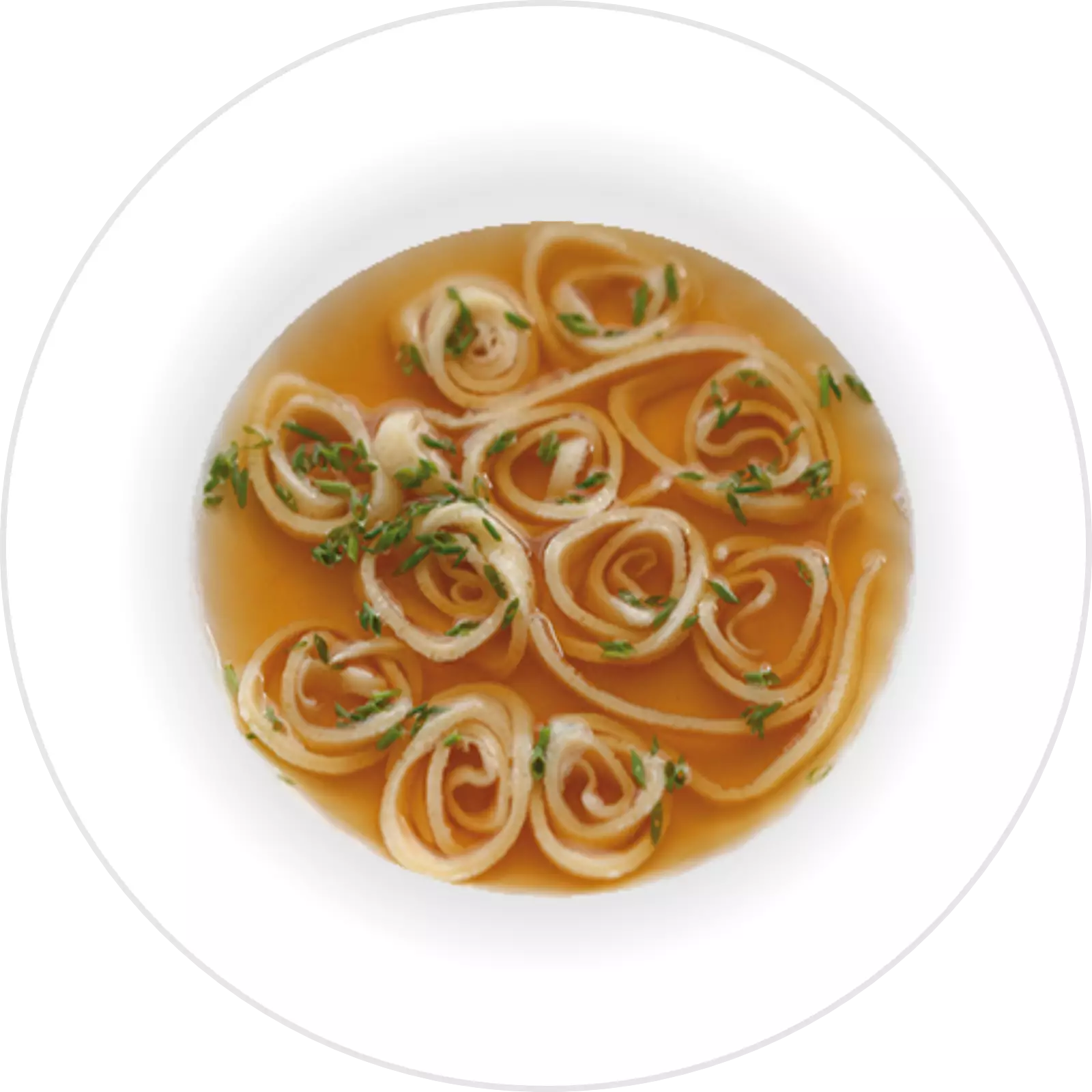
to sweet selections Apple doughnuts with vanilla sauce
to sweet selections
- 5 große, säuerliche Äpfel
- 200 Gramm Mehl
- 2 Eier
- 250 ml Milch
- 2 EL Rum
- Nach Bedarf Schmalz oder Öl
- Nach Belieben Zimt, Zucker, Salz
Peel the apples and remove the core, cut into finger-thick, even slices. Drizzle with rum and sugar. Leave to infuse.
Stir the batter, it should be quite thick. Turn the apple rings in it and bake floating in hot fat until golden brown.
<p
<p>Drain on kitchen paper and serve hot with cinnamon and sugar.
- Riesling (süß & edelsüß)
- Scheurebe (süß & edelsüß)
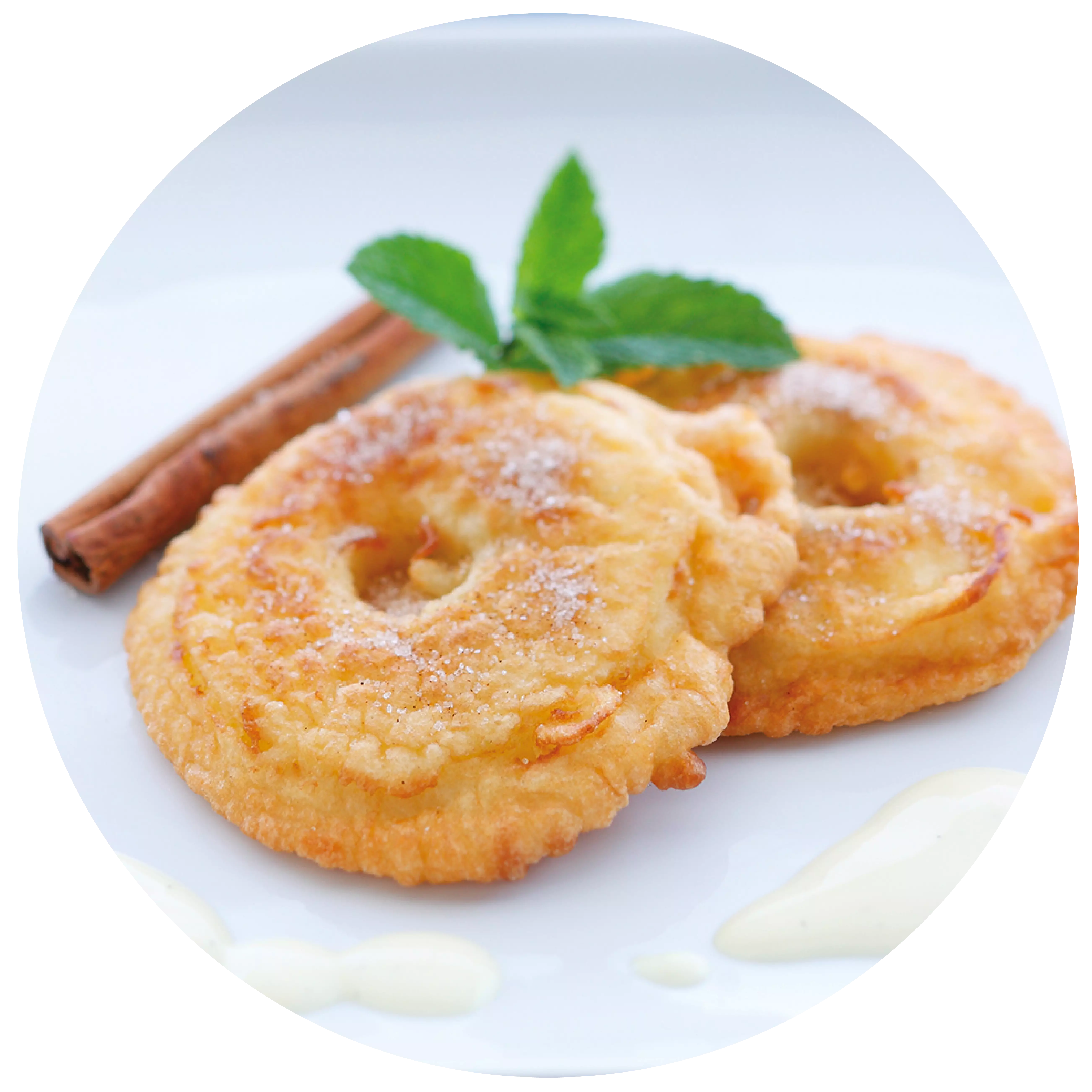
Asparagus harmonises perfectly with Silvaner Roasted asparagus with wild garlic and ribbon noodles
Roasted asparagus with wild garlic and ribbon noodles goes perfectly with Silvaner.
- 1kg weißer Spargel
- 1kg grüner Spargel
- 200g Butter
- 1 TL Zucker
- 2-4 EL Walnussöl
- 600g Tagliatelle
- 1 Prise Salz und Pfeffer
- 200 ml Schlagsahne
- 1 Spritzer Zitronensaft
- 8 Bärlauchblätter
Preparation:
Peel the asparagus (green asparagus only in the lower third), cut off the ends. Cut each spear in half lengthways and cut the halves in half. Cut the halves into 3 – 5 cm long pieces.
Heat the butter in a large pan, add the sugar. Caramelise briefly. Add the oil and asparagus and cook over a medium heat for approx. 10 mins. until al dente, tossing occasionally.
In the meantime, cook the tagliatelle in boiling salted water according to the pack instructions until al dente.
Pour the cream into the asparagus and reduce until creamy. Season the asparagus with salt, pepper and lemon juice.
Rinse the pasta, drain and mix with the asparagus. Cut the spring onions into strips and fold in.
Wine recommendation:
Silvaner Spätlese dry
- Silvaner (trocken)

Events
-
Show
winetasting in our winery - blind tasting
Mainz-Hechtsheim


